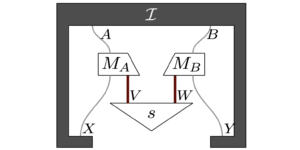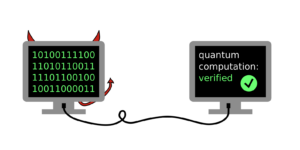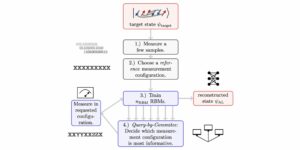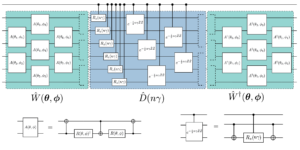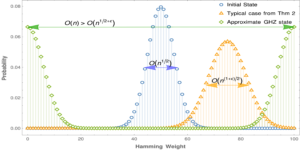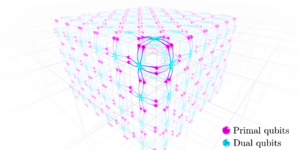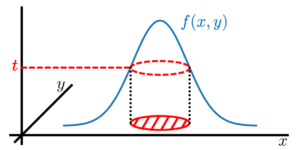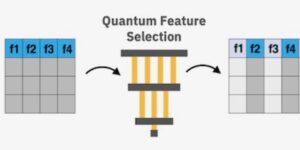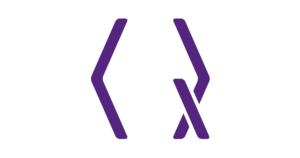1Cisco Quantum Lab, San Jose, CA 95134, USA
2Cisco Quantum Lab, Los Angeles, CA 90049, USA
Find this paper interesting or want to discuss? Scite or leave a comment on SciRate.
Abstract
Graph states are a family of stabilizer states which can be tailored towards various applications in photonic quantum computing and quantum communication. In this paper, we present a modular design based on quantum dot emitters coupled to a waveguide and optical fiber delay lines to deterministically generate N-dimensional cluster states and other useful graph states such as tree states and repeater states. Unlike previous proposals, our design requires no two-qubit gates on quantum dots and at most one optical switch, thereby, minimizing challenges usually posed by these requirements. Furthermore, we discuss the error model for our design and demonstrate a fault-tolerant quantum memory with an error threshold of 0.53% in the case of a 3d graph state on a Raussendorf-Harrington-Goyal (RHG) lattice. We also provide a fundamental upper bound on the correctable loss in the fault-tolerant RHG state based on the percolation theory, which is 1.24 dB or 0.24 dB depending on whether the state is directly generated or obtained from a simple cubic cluster state, respectively.
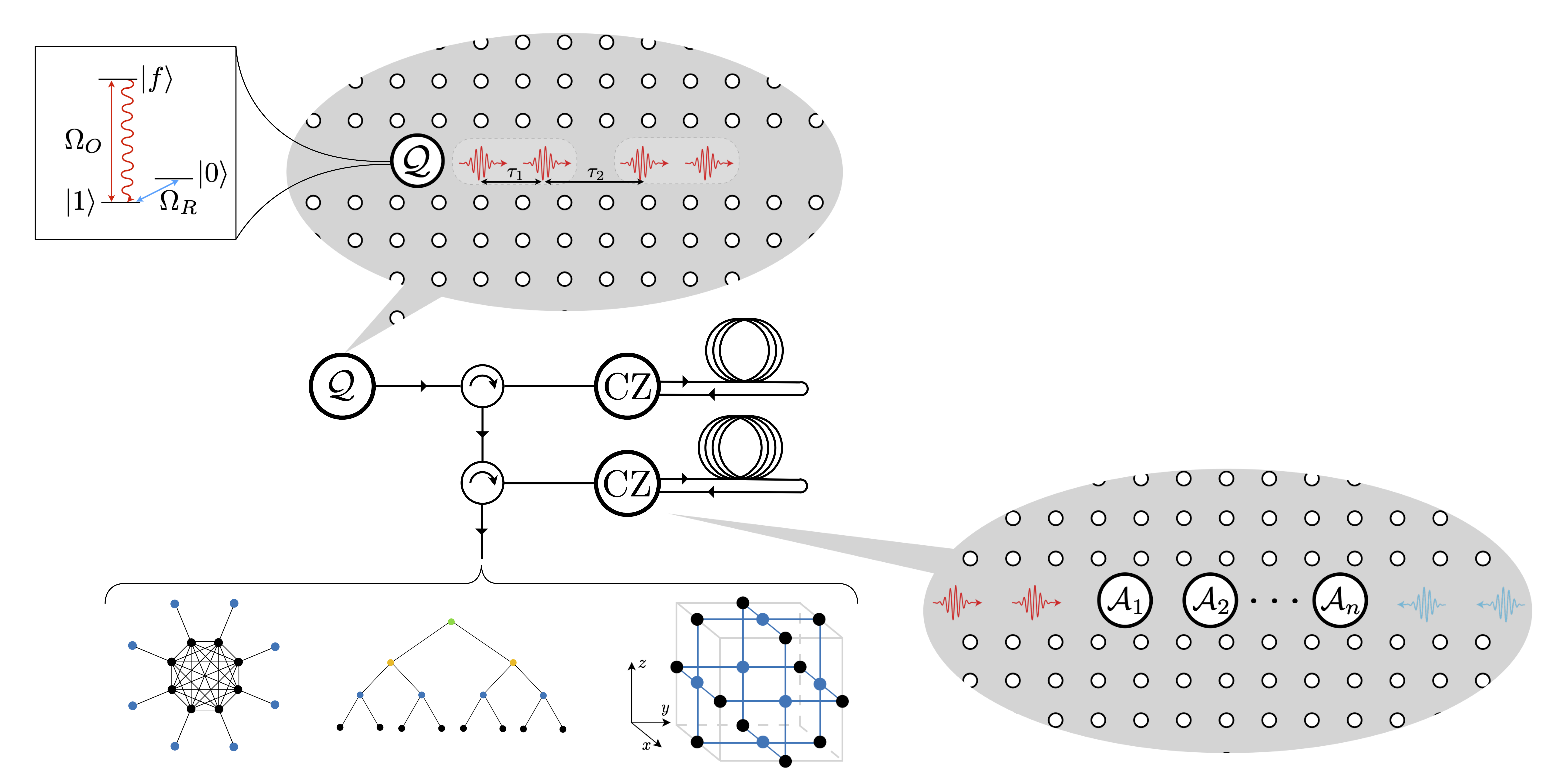
Featured image: A schematic picture of our modular architecture to generate graph states of photonic qubits. It consists of two parts: An active component, a quantum emitter (Q) which sends photons to the second (passive) component, comprising an optical circulator attached to a scattering block (which acts as a CZ gate) terminated by a delay-line feedback loop. Some sample output graph states are shown at the output.
Popular summary
Our architecture is modular, i.e., stacking the scattering blocks leads to devices capable of generating more sophisticated states (e.g., higher-dimensional graph states).
► BibTeX data
► References
[1] Jeremy L. O’Brien, Akira Furusawa, and Jelena Vučković. “Photonic quantum technologies”. Nature Photonics 3, 687 (2009).
https://doi.org/10.1038/nphoton.2009.229
[2] S. Bogdanov, M. Y. Shalaginov, A. Boltasseva, and V. M. Shalaev. “Material platforms for integrated quantum photonics”. Opt. Mater. Express 7, 111–132 (2017).
https://doi.org/10.1364/OME.7.000111
[3] E. Knill, R. Laflamme, and G. J. Milburn. “A scheme for efficient quantum computation with linear optics”. Nature 409, 46 (2001).
https://doi.org/10.1038/35051009
[4] T. C. Ralph, N. K. Langford, T. B. Bell, and A. G. White. “Linear optical controlled-not gate in the coincidence basis”. Phys. Rev. A 65, 062324 (2002).
https://doi.org/10.1103/PhysRevA.65.062324
[5] Holger F. Hofmann and Shigeki Takeuchi. “Quantum phase gate for photonic qubits using only beam splitters and postselection”. Phys. Rev. A 66, 024308 (2002).
https://doi.org/10.1103/PhysRevA.66.024308
[6] Daniel E. Browne and Terry Rudolph. “Resource-efficient linear optical quantum computation”. Phys. Rev. Lett. 95, 010501 (2005).
https://doi.org/10.1103/PhysRevLett.95.010501
[7] H. J. Briegel, D. E. Browne, W. Dür, R. Raussendorf, and M. Van den Nest. “Measurement-based quantum computation”. Nature Physics 5, 19–26 (2009).
https://doi.org/10.1038/nphys1157
[8] M. Zwerger, H. J. Briegel, and W. Dür. “Measurement-based quantum communication”. Appl. Phys. B 122, 50 (2016).
https://doi.org/10.1007/s00340-015-6285-8
[9] Robert Raussendorf, Daniel E. Browne, and Hans J. Briegel. “Measurement-based quantum computation on cluster states”. Phys. Rev. A 68, 022312 (2003).
https://doi.org/10.1103/PhysRevA.68.022312
[10] Robert Raussendorf and Hans J. Briegel. “A one-way quantum computer”. Phys. Rev. Lett. 86, 5188–5191 (2001).
https://doi.org/10.1103/PhysRevLett.86.5188
[11] Michael A. Nielsen. “Optical quantum computation using cluster states”. Phys. Rev. Lett. 93, 040503 (2004).
https://doi.org/10.1103/PhysRevLett.93.040503
[12] R. Raussendorf, J. Harrington, and K. Goyal. “A fault-tolerant one-way quantum computer”. Annals of Physics 321, 2242–2270 (2006).
https://doi.org/10.1016/j.aop.2006.01.012
[13] M. Zwerger, W. Dür, and H. J. Briegel. “Measurement-based quantum repeaters”. Phys. Rev. A 85, 062326 (2012).
https://doi.org/10.1103/PhysRevA.85.062326
[14] M. Zwerger, H. J. Briegel, and W. Dür. “Universal and optimal error thresholds for measurement-based entanglement purification”. Phys. Rev. Lett. 110, 260503 (2013).
https://doi.org/10.1103/PhysRevLett.110.260503
[15] K. Azuma, K. Tamaki, and H.-K. Lo. “All-photonic quantum repeaters”. Nat. Commun. 6, 6787 (2015).
https://doi.org/10.1038/ncomms7787
[16] J. Wallnöfer, M. Zwerger, C. Muschik, N. Sangouard, and W. Dür. “Two-dimensional quantum repeaters”. Phys. Rev. A 94, 052307 (2016).
https://doi.org/10.1103/PhysRevA.94.052307
[17] Johannes Borregaard, Hannes Pichler, Tim Schröder, Mikhail D. Lukin, Peter Lodahl, and Anders S. Sørensen. “One-way quantum repeater based on near-deterministic photon-emitter interfaces”. Phys. Rev. X 10, 021071 (2020).
https://doi.org/10.1103/PhysRevX.10.021071
[18] Sam Morley-Short, Mercedes Gimeno-Segovia, Terry Rudolph, and Hugo Cable. “Loss-tolerant teleportation on large stabilizer states”. Quantum Science and Technology 4, 025014 (2019).
https://doi.org/10.1088/2058-9565/aaf6c4
[19] Adeline Orieux, Marijn A M Versteegh, Klaus D Jöns, and Sara Ducci. “Semiconductor devices for entangled photon pair generation: a review”. Reports on Progress in Physics 80, 076001 (2017).
https://doi.org/10.1088/1361-6633/aa6955
[20] Galan Moody, Volker J Sorger, Daniel J Blumenthal, Paul W Juodawlkis, William Loh, Cheryl Sorace-Agaskar, Alex E Jones, Krishna C Balram, Jonathan C F Matthews, Anthony Laing, Marcelo Davanco, Lin Chang, John E Bowers, Niels Quack, Christophe Galland, Igor Aharonovich, Martin A Wolff, Carsten Schuck, Neil Sinclair, Marko Lončar, Tin Komljenovic, David Weld, Shayan Mookherjea, Sonia Buckley, Marina Radulaski, Stephan Reitzenstein, Benjamin Pingault, Bartholomeus Machielse, Debsuvra Mukhopadhyay, Alexey Akimov, Aleksei Zheltikov, Girish S Agarwal, Kartik Srinivasan, Juanjuan Lu, Hong X Tang, Wentao Jiang, Timothy P McKenna, Amir H Safavi-Naeini, Stephan Steinhauer, Ali W Elshaari, Val Zwiller, Paul S Davids, Nicholas Martinez, Michael Gehl, John Chiaverini, Karan K Mehta, Jacquiline Romero, Navin B Lingaraju, Andrew M Weiner, Daniel Peace, Robert Cernansky, Mirko Lobino, Eleni Diamanti, Luis Trigo Vidarte, and Ryan M Camacho. “2022 roadmap on integrated quantum photonics”. Journal of Physics: Photonics 4, 012501 (2022).
https://doi.org/10.1088/2515-7647/ac1ef4
[21] Jeremy C. Adcock, Caterina Vigliar, Raffaele Santagati, Joshua W. Silverstone, and Mark G. Thompson. “Programmable four-photon graph states on a silicon chip”. Nat. Commun. 10, 3528 (2019).
https://doi.org/10.1038/s41467-019-11489-y
[22] Igor Aharonovich, Dirk Englund, and Milos Toth. “Solid-state single-photon emitters”. Nature Photonics 10, 631 (2016).
https://doi.org/10.1038/nphoton.2016.186
[23] Pascale Senellart, Glenn Solomon, and Andrew White. “High-performance semiconductor quantum-dot single-photon sources”. Nature Nanotechnology 12, 1026 (2017).
https://doi.org/10.1038/nnano.2017.218
[24] Alisa Javadi, Dapeng Ding, Martin Hayhurst Appel, Sahand Mahmoodian, Matthias Christian Löbl, Immo Söllner, Rüdiger Schott, Camille Papon, Tommaso Pregnolato, Søren Stobbe, Leonardo Midolo, Tim Schröder, Andreas Dirk Wieck, Arne Ludwig, Richard John Warburton, and Peter Lodahl. “Spin–photon interface and spin-controlled photon switching in a nanobeam waveguide”. Nature Nanotechnology 13, 398 (2018).
https://doi.org/10.1038/s41565-018-0091-5
[25] Hanna Le Jeannic, Alexey Tiranov, Jacques Carolan, Tomás Ramos, Ying Wang, Martin H. Appel, Sven Scholz, Andreas D. Wieck, Arne Ludwig, Nir Rotenberg, Leonardo Midolo, Juan José García-Ripoll, Anders S. Sørensen, and Peter Lodahl. “Dynamical photon-photon interaction mediated by a quantum emitter”. Nature Physics 18, 1191–1195 (2022).
https://doi.org/10.1038/s41567-022-01720-x
[26] Björn Schrinski, Miren Lamaison, and Anders S. Sørensen. “Passive quantum phase gate for photons based on three level emitters”. Phys. Rev. Lett. 129, 130502 (2022).
https://doi.org/10.1103/PhysRevLett.129.130502
[27] Ravitej Uppu, Freja T. Pedersen, Ying Wang, Cecilie T. Olesen, Camille Papon, Xiaoyan Zhou, Leonardo Midolo, Sven Scholz, Andreas D. Wieck, Arne Ludwig, and Peter Lodahl. “Scalable integrated single-photon source”. Science Advances 6, eabc8268 (2020).
https://doi.org/10.1126/sciadv.abc8268
[28] Natasha Tomm, Alisa Javadi, Nadia Olympia Antoniadis, Daniel Najer, Matthias Christian Löbl, Alexander Rolf Korsch, Rüdiger Schott, Sascha René Valentin, Andreas Dirk Wieck, Arne Ludwig, and Richard John Warburton. “A bright and fast source of coherent single photons”. Nature Nanotechnology 16, 399 (2021).
https://doi.org/10.1038/s41565-020-00831-x
[29] Ravitej Uppu, Leonardo Midolo, Xiaoyan Zhou, Jacques Carolan, and Peter Lodahl. “Quantum-dot-based deterministic photon–emitter interfaces for scalable photonic quantum technology”. Nature Nanotechnology 16, 1308 (2021).
https://doi.org/10.1038/s41565-021-00965-6
[30] Netanel H. Lindner and Terry Rudolph. “Proposal for pulsed on-demand sources of photonic cluster state strings”. Phys. Rev. Lett. 103, 113602 (2009).
https://doi.org/10.1103/PhysRevLett.103.113602
[31] Ido Schwartz, Dan Cogan, Emma R. Schmidgall, Yaroslav Don, Liron Gantz, Oded Kenneth, Netanel H. Lindner, and David Gershoni. “Deterministic generation of a cluster state of entangled photons”. Science 354, 434 (2016).
https://doi.org/10.1126/science.aah4758
[32] Philip Thomas, Leonardo Ruscio, Olivier Morin, and Gerhard Rempe. “Efficient generation of entangled multi-photon graph states from a single atom”. Nature 608, 677–681 (2022).
https://doi.org/10.1038/s41586-022-04987-5
[33] Sophia E. Economou, Netanel Lindner, and Terry Rudolph. “Optically generated 2-dimensional photonic cluster state from coupled quantum dots”. Phys. Rev. Lett. 105, 093601 (2010).
https://doi.org/10.1103/PhysRevLett.105.093601
[34] Mercedes Gimeno-Segovia, Terry Rudolph, and Sophia E. Economou. “Deterministic generation of large-scale entangled photonic cluster state from interacting solid state emitters”. Phys. Rev. Lett. 123, 070501 (2019).
https://doi.org/10.1103/PhysRevLett.123.070501
[35] Donovan Buterakos, Edwin Barnes, and Sophia E. Economou. “Deterministic generation of all-photonic quantum repeaters from solid-state emitters”. Phys. Rev. X 7, 041023 (2017).
https://doi.org/10.1103/PhysRevX.7.041023
[36] Antonio Russo, Edwin Barnes, and Sophia E Economou. “Generation of arbitrary all-photonic graph states from quantum emitters”. New Journal of Physics 21, 055002 (2019).
https://doi.org/10.1088/1367-2630/ab193d
[37] Paul Hilaire, Edwin Barnes, and Sophia E. Economou. “Resource requirements for efficient quantum communication using all-photonic graph states generated from a few matter qubits”. Quantum 5, 397 (2021).
https://doi.org/10.22331/q-2021-02-15-397
[38] B. Li, S. E. Economou, and E. Barnes. “Photonic resource state generation from a minimal number of quantum emitters”. npj Quantum Information 8, 11 (2022).
https://doi.org/10.1038/s41534-022-00522-6
[39] Hannes Pichler and Peter Zoller. “Photonic circuits with time delays and quantum feedback”. Phys. Rev. Lett. 116, 093601 (2016).
https://doi.org/10.1103/PhysRevLett.116.093601
[40] Hannes Pichler, Soonwon Choi, Peter Zoller, and Mikhail D. Lukin. “Universal photonic quantum computation via time-delayed feedback”. Proceedings of the National Academy of Sciences 114, 11362–11367 (2017).
https://doi.org/10.1073/pnas.1711003114
[41] Kianna Wan, Soonwon Choi, Isaac H. Kim, Noah Shutty, and Patrick Hayden. “Fault-tolerant qubit from a constant number of components”. PRX Quantum 2, 040345 (2021).
https://doi.org/10.1103/PRXQuantum.2.040345
[42] Yuan Zhan and Shuo Sun. “Deterministic generation of loss-tolerant photonic cluster states with a single quantum emitter”. Phys. Rev. Lett. 125, 223601 (2020).
https://doi.org/10.1103/PhysRevLett.125.223601
[43] J. Brendel, N. Gisin, W. Tittel, and H. Zbinden. “Pulsed energy-time entangled twin-photon source for quantum communication”. Phys. Rev. Lett. 82, 2594–2597 (1999).
https://doi.org/10.1103/PhysRevLett.82.2594
[44] Sean D. Barrett and Thomas M. Stace. “Fault tolerant quantum computation with very high threshold for loss errors”. Phys. Rev. Lett. 105, 200502 (2010).
https://doi.org/10.1103/PhysRevLett.105.200502
[45] M. Arcari, I. Söllner, A. Javadi, S. Lindskov Hansen, S. Mahmoodian, J. Liu, H. Thyrrestrup, E. H. Lee, J. D. Song, S. Stobbe, and P. Lodahl. “Near-unity coupling efficiency of a quantum emitter to a photonic crystal waveguide”. Phys. Rev. Lett. 113, 093603 (2014).
https://doi.org/10.1103/PhysRevLett.113.093603
[46] Konstantin Tiurev, Martin Hayhurst Appel, Pol Llopart Mirambell, Mikkel Bloch Lauritzen, Alexey Tiranov, Peter Lodahl, and Anders Søndberg Sørensen. “High-fidelity multi-photon-entangled cluster state with solid-state quantum emitters in photonic nanostructures” (2020). arXiv:2007.09295.
arXiv:2007.09295
[47] M. Hein, W. Dür, J. Eisert, R. Raussendorf, M. Van den Nest, and H.-J. Briegel. “Entanglement in graph states and its applications” (2006). arXiv:quant-ph/0602096.
arXiv:quant-ph/0602096
[48] Robert Raussendorf, Sergey Bravyi, and Jim Harrington. “Long-range quantum entanglement in noisy cluster states”. Phys. Rev. A 71, 062313 (2005).
https://doi.org/10.1103/PhysRevA.71.062313
[49] Martin Hayhurst Appel, Alexey Tiranov, Alisa Javadi, Matthias C. Löbl, Ying Wang, Sven Scholz, Andreas D. Wieck, Arne Ludwig, Richard J. Warburton, and Peter Lodahl. “Coherent spin-photon interface with waveguide induced cycling transitions”. Phys. Rev. Lett. 126, 013602 (2021).
https://doi.org/10.1103/PhysRevLett.126.013602
[50] Peter Lodahl, Sahand Mahmoodian, S Stobbe, Arno Rauschenbeutel, Philipp Schneeweiss, Jurgen Volz, Hannes Pichler, and Peter Zoller. “Chiral quantum optics”. Nature 541, 473 (2017).
https://doi.org/10.1038/nature21037
[51] J. T. Shen and Shanhui Fan. “Coherent photon transport from spontaneous emission in one-dimensional waveguides”. Opt. Lett. 30, 2001–2003 (2005).
https://doi.org/10.1364/OL.30.002001
[52] Jung-Tsung Shen and Shanhui Fan. “Strongly correlated multiparticle transport in one dimension through a quantum impurity”. Phys. Rev. A 76, 062709 (2007).
https://doi.org/10.1103/PhysRevA.76.062709
[53] T. C. Ralph, I. Söllner, S. Mahmoodian, A. G. White, and P. Lodahl. “Photon sorting, efficient bell measurements, and a deterministic controlled-$z$ gate using a passive two-level nonlinearity”. Phys. Rev. Lett. 114, 173603 (2015).
https://doi.org/10.1103/PhysRevLett.114.173603
[54] R Raussendorf, J Harrington, and K Goyal. “Topological fault-tolerance in cluster state quantum computation”. New J. Phys. 9, 199–199 (2007).
https://doi.org/10.1088/1367-2630/9/6/199
[55] Mihir Pant, Hari Krovi, Dirk Englund, and Saikat Guha. “Rate-distance tradeoff and resource costs for all-optical quantum repeaters”. Phys. Rev. A 95, 012304 (2017).
https://doi.org/10.1103/PhysRevA.95.012304
[56] K. Azuma, K. Tamaki, and W.J. Munro. “All-photonic intercity quantum key distribution”. Nat. Commun. 6, 10171 (2015).
https://doi.org/10.1038/ncomms10171
[57] Maarten Van den Nest, Jeroen Dehaene, and Bart De Moor. “Graphical description of the action of local clifford transformations on graph states”. Phys. Rev. A 69, 022316 (2004).
https://doi.org/10.1103/PhysRevA.69.022316
[58] M. Hein, J. Eisert, and H. J. Briegel. “Multiparty entanglement in graph states”. Phys. Rev. A 69, 062311 (2004).
https://doi.org/10.1103/PhysRevA.69.062311
[59] Michael Varnava, Daniel E. Browne, and Terry Rudolph. “Loss tolerance in one-way quantum computation via counterfactual error correction”. Phys. Rev. Lett. 97, 120501 (2006).
https://doi.org/10.1103/PhysRevLett.97.120501
[60] Chenyang Wang, Jim Harrington, and John Preskill. “Confinement-higgs transition in a disordered gauge theory and the accuracy threshold for quantum memory”. Annals of Physics 303, 31–58 (2003).
https://doi.org/10.1016/S0003-4916(02)00019-2
[61] Jack Edmonds. “Paths, trees, and flowers”. Can. J. Math. 17, 449–467 (1965).
https://doi.org/10.4153/CJM-1965-045-4
[62] Oscar Higgott. “PyMatching: A python package for decoding quantum codes with minimum-weight perfect matching” (2021). arXiv:2105.13082.
arXiv:2105.13082
[63] Robert Raussendorf and Jim Harrington. “Fault-tolerant quantum computation with high threshold in two dimensions”. Phys. Rev. Lett. 98, 190504 (2007).
https://doi.org/10.1103/PhysRevLett.98.190504
[64] Thomas M. Stace and Sean D. Barrett. “Error correction and degeneracy in surface codes suffering loss”. Phys. Rev. A 81, 022317 (2010).
https://doi.org/10.1103/PhysRevA.81.022317
[65] Thomas M. Stace, Sean D. Barrett, and Andrew C. Doherty. “Thresholds for topological codes in the presence of loss”. Phys. Rev. Lett. 102, 200501 (2009).
https://doi.org/10.1103/PhysRevLett.102.200501
[66] Adam C. Whiteside and Austin G. Fowler. “Upper bound for loss in practical topological-cluster-state quantum computing”. Phys. Rev. A 90, 052316 (2014).
https://doi.org/10.1103/PhysRevA.90.052316
[67] Nicolas Delfosse and Gilles Zémor. “Linear-time maximum likelihood decoding of surface codes over the quantum erasure channel”. Phys. Rev. Research 2, 033042 (2020).
https://doi.org/10.1103/PhysRevResearch.2.033042
[68] Brian Skinner, Jonathan Ruhman, and Adam Nahum. “Measurement-induced phase transitions in the dynamics of entanglement”. Phys. Rev. X 9, 031009 (2019).
https://doi.org/10.1103/PhysRevX.9.031009
[69] E. Togan, Y. Chu, A. S. Trifonov, L. Jiang, J. Maze, L. Childress, M.V.G. Dutt, A.S. Sørensen, P.R. Hemmer, A.S. Zibrov, and M.D. Lukin. “Quantum entanglement between an optical photon and a solid-state spin qubit”. Nature 466, 730 (2010).
https://doi.org/10.1038/nature09256
[70] L.-M. Duan, M. D. Lukin, J. I. Cirac, and P. Zoller. “Long-distance quantum communication with atomic ensembles and linear optics”. Nature 414, 413 (2001).
https://doi.org/10.1038/35106500
[71] N. Somaschi, V. Giesz, L. De Santis, J. C. Loredo, M. P. Almeida, G. Hornecker, S. L. Portalupi, T. Grange, C. Antón, J. Demory, C. Gómez, I. Sagnes, N. D. Lanzillotti-Kimura, A. Lemaítre, A. Auffeves, A. G. White, L. Lanco, and P. Senellart. “Near-optimal single-photon sources in the solid state”. Nature Photonics 10, 340–345 (2016).
https://doi.org/10.1038/nphoton.2016.23
[72] Naomi Nickerson and Héctor Bombín. “Measurement based fault tolerance beyond foliation” (2018). arXiv:1810.09621.
arXiv:1810.09621
[73] Michael Newman, Leonardo Andreta de Castro, and Kenneth R. Brown. “Generating Fault-Tolerant Cluster States from Crystal Structures”. Quantum 4, 295 (2020).
https://doi.org/10.22331/q-2020-07-13-295
[74] Serge Galam and Alain Mauger. “Universal formulas for percolation thresholds”. Phys. Rev. E 53, 2177–2181 (1996).
https://doi.org/10.1103/PhysRevE.53.2177
Cited by
[1] Daoheng Niu, Yuxuan Zhang, Alireza Shabani, and Hassan Shapourian, “All-photonic one-way quantum repeaters”, arXiv:2210.10071, (2022).
[2] Yuan Zhan, Paul Hilaire, Edwin Barnes, Sophia E. Economou, and Shuo Sun, “Performance analysis of quantum repeaters enabled by deterministically generated photonic graph states”, arXiv:2209.11430, (2022).
The above citations are from SAO/NASA ADS (last updated successfully 2023-03-02 16:55:13). The list may be incomplete as not all publishers provide suitable and complete citation data.
Could not fetch Crossref cited-by data during last attempt 2023-03-02 16:55:11: Could not fetch cited-by data for 10.22331/q-2023-03-02-935 from Crossref. This is normal if the DOI was registered recently.
This Paper is published in Quantum under the Creative Commons Attribution 4.0 International (CC BY 4.0) license. Copyright remains with the original copyright holders such as the authors or their institutions.
- SEO Powered Content & PR Distribution. Get Amplified Today.
- Platoblockchain. Web3 Metaverse Intelligence. Knowledge Amplified. Access Here.
- Source: https://quantum-journal.org/papers/q-2023-03-02-935/
- 1
- 10
- 11
- 116
- 1996
- 1999
- 2001
- 2012
- 2014
- 2016
- 2017
- 2018
- 2019
- 2020
- 2021
- 2022
- 28
- 39
- 3d
- 67
- 7
- 70
- 9
- 98
- a
- above
- ABSTRACT
- Academy
- access
- accuracy
- achieved
- Action
- active
- acts
- Adam
- advances
- affiliations
- alex
- Alexander
- All
- analysis
- analyze
- and
- Andrew
- Angeles
- Anthony
- applications
- architecture
- atom
- author
- authors
- based
- basis
- Beam
- Bell
- Benjamin
- between
- Beyond
- Block
- Blocks
- Bound
- Break
- Brian
- Bright
- CA
- cable
- candidates
- capable
- case
- challenges
- challenging
- Channel
- chip
- choice
- Cluster
- COHERENT
- coincidence
- comment
- Common
- Commons
- Communication
- complete
- component
- components
- computation
- computer
- computers
- computing
- constant
- copyright
- Costs
- could
- coupled
- Crystal
- CZ
- Daniel
- data
- David
- Decoding
- delay
- delays
- demonstrate
- Depending
- description
- Design
- destroyed
- Development
- Devices
- differences
- Dimension
- dimensions
- directly
- discuss
- distinct
- distribution
- DOT
- during
- dynamics
- Edwin
- efficiency
- efficient
- emission
- enabled
- error
- Errors
- express
- family
- fan
- FAST
- feedback
- few
- flying
- from
- fundamental
- Furthermore
- Gates
- generate
- generated
- generating
- generation
- get
- Gilles
- graph
- harvard
- High
- holders
- Hong
- However
- HTTPS
- hugo
- IDO
- image
- in
- information
- institutions
- integrated
- interacting
- interaction
- interesting
- Interface
- interfaces
- International
- IT
- jack
- JavaScript
- Jim
- John
- journal
- Key
- Kim
- lab
- large
- large-scale
- Last
- Leads
- Leave
- Led
- Lee
- Level
- Li
- License
- light
- lines
- List
- local
- los
- Los Angeles
- loss
- mark
- Martin
- matching
- math
- Matter
- max-width
- maximum
- measurements
- measuring
- medium
- Memory
- methods
- Michael
- minimal
- minimizing
- model
- modular
- Month
- more
- most
- nanotechnology
- National
- Nature
- Nest
- networking
- networks
- New
- Nicolas
- Noah
- normal
- number
- obtained
- Olivier
- ONE
- open
- optics
- optimal
- original
- Other
- package
- Paper
- parts
- passive
- Paul
- perfect
- performance
- Peter
- phase
- Photons
- Physics
- picture
- Platforms
- plato
- Plato Data Intelligence
- PlatoData
- Practical
- prepared
- presence
- present
- previous
- Proceedings
- processing
- Progress
- promising
- Proposals
- propose
- provide
- published
- publisher
- publishers
- Python
- Quantum
- Quantum Computer
- quantum computers
- quantum computing
- Quantum dot
- Quantum dots
- quantum entanglement
- quantum information
- quantum networks
- Quantum optics
- quantum particles
- quantum technology
- Qubit
- qubits
- recently
- references
- registered
- remains
- Reports
- Requirements
- requires
- research
- resource
- review
- Richard
- roadmap
- ROBERT
- Ryan
- Sam
- San
- San Jose
- scalable
- scheme
- Science
- Science and Technology
- SCIENCES
- Sean
- Second
- semiconductor
- shown
- Silicon
- Silverstone
- Simple
- single
- solid
- some
- sophisticated
- Source
- Sources
- speed
- Spin
- stacking
- State
- States
- Successfully
- such
- suffering
- suitable
- Sun
- Surface
- Switch
- tailored
- tasks
- Technologies
- Technology
- The
- The State
- their
- thereby
- three
- threshold
- Through
- Tim
- time
- Title
- to
- tolerance
- towards
- transformations
- transition
- transitions
- transport
- Trees
- under
- updated
- URL
- usually
- various
- via
- volume
- W
- whether
- which
- white
- X
- year
- YING
- Yuan
- zephyrnet



